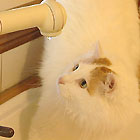Breed: Turkish Van
Temperament: outgoing, independent
Lifespan: 10 – 12 years
Maintenance: medium-high
Recommended for: committed and outgoing people
History
Although said to have originated in the Lake Van district in the remote southeast region of Turkey, there is little evidence of this type having actually come from this area. Enthusiasm for the breed saw its popularity spread across Europe in the mid 1950s and crosses with British Shorthair were likely to have contributed to the current colour variations. It was not until the 1980s that Turkish Vans were bred in earnest in Australia.
Appearance
The Turkish Van is a large, well muscled cat. The coat patterning is so distinctive that it shares the same name as the breed. The ‘van’ pattern has a distinctive white ‘thumb print’ mark between the ears and a coloured tail. The coat is soft, semi-long and predominantly white, with colouring on the tail and forehead on either side of the thumb print. Breeders prefer the ears to be white. One or two patches of colour may also be evident along the spine, just forward of the tail. Colours are limited to auburn (regarded as red amongst other breeds), cream, blue, black and tortoise shell. Eye colour is either amber or blue, or even one of each.
Temperament
Loyal, loving and inquisitive, yet not as needy as some other cat breeds. Turkish Vans are very playful, but are also happy to be left alone during the day. These cats have wonderful temperaments, are often described as dog-like and are great with kids. Fetch and catch are popular games. Some breeders do report that vans are accomplished hunters.
Often described as the swimming cat, the Turkish Van has a natural attraction to water. However do not be misled by this description. These cats don’t like to swim, so don’t put them in the pool. The attraction to water usually only extends to a fascination with dripping taps, water bowls and hoses.
Health and lifespan
Regarded as a strong, healthy breed. There are no known heritable diseases common to Turkish Vans, though pale skin on the ears and nose can make them susceptible to sunburn and skin cancer. If your cat is exposed to sunlight for prolonged periods of time, just apply a smear of waterproof sunblock to those vulnerable areas. As with other long-coat breeds, furballs can develop especially when the winter coat is shedding. Average lifespan of 10 -12 years.
Space and exercise
This active breed may find life in an apartment a bit too restrictive. However if you are an active person with time to spend with your Turkish Van during the day, you should be able to keep each other entertained. Turkish Vans are known to play fetch particularly well, so if puss is a bit too active, a quick game with its favourite toy may do the trick.
Maintenance and cost
The level of maintenance depends on the season. Turkish Vans develop a thick winter coat and are heavy shedders when the weather starts to warm up. During the seasonal moult, once daily grooming is required until the coat has fully lifted. During winter, whilst the coat is long but stable, a groom twice weekly is recommended. Once a week will suffice in summer as the coat becomes quite short. A pet will cost between $500 – $1000.
Recommended for
Ideal for cat lovers who don’t mind an independent, outgoing breed. Great as child’s pet too. The breed’s strong hunting instincts suggests that a purpose-built cat enclosure is ideal to house the animal. Prospective owners should also be prepared to groom their Turkish Van regularly during the moulting season.
Further information
We filmed this segment with Bernadette Roberts and Cindy Cairns, both Turkish Van breeders. Bernadette, from Queensland, can be contacted on (07) 3856 4948. Cindy, from New South Wales, can be contacted on (02) 9892 2592.
Turkish Delight Breed Group
Secretary: Bernadette Roberts
Phone: (07) 3856 4948
Fax: (07) 3856 5318
email: [email protected]



